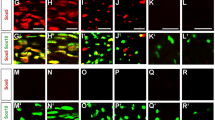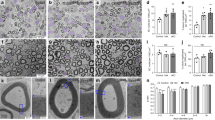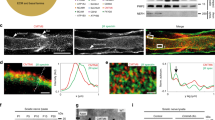Abstract
Fast axonal conduction depends on myelin, which is formed by Schwann cells in the PNS. We found that the transcription factor Yin Yang 1 (YY1) is crucial for peripheral myelination. Conditional ablation of Yy1 in the Schwann cell lineage resulted in severe hypomyelination, which occurred independently of altered Schwann cell proliferation or apoptosis. In Yy1 mutant mice, Schwann cells established a 1:1 relationship with axons but were unable to myelinate them. The Schwann cells expressed low levels of myelin proteins and of Egr2 (also called Krox20), which is an important regulator of peripheral myelination. In vitro, Schwann cells that lacked Yy1 did not upregulate Egr2 in response to neuregulin1 and did not express myelin protein zero. This phenotype was rescued by overexpression of Egr2. In addition, neuregulin-induced phosphorylation of YY1 was required for transcriptional activation of Egr2. Thus, YY1 emerges as an important activator of peripheral myelination that links neuregulin signaling with Egr2 expression.
This is a preview of subscription content, access via your institution
Access options
Subscribe to this journal
Receive 12 print issues and online access
$209.00 per year
only $17.42 per issue
Buy this article
- Purchase on Springer Link
- Instant access to full article PDF
Prices may be subject to local taxes which are calculated during checkout








Similar content being viewed by others
Accession codes
References
Jessen, K.R. & Mirsky, R. The origin and development of glial cells in peripheral nerves. Nat. Rev. Neurosci. 6, 671–682 (2005).
Michailov, G.V. et al. Axonal neuregulin-1 regulates myelin sheath thickness. Science 304, 700–703 (2004).
Nave, K.A. & Salzer, J.L. Axonal regulation of myelination by neuregulin 1. Curr. Opin. Neurobiol. 16, 492–500 (2006).
Taveggia, C. et al. Neuregulin-1 type III determines the ensheathment fate of axons. Neuron 47, 681–694 (2005).
Chan, R., Hardy, W.R., Dankort, D., Laing, M.A. & Muller, W.J. Modulation of Erbb2 signaling during development: a threshold level of Erbb2 signaling is required for development. Development 131, 5551–5560 (2004).
Garratt, A.N., Voiculescu, O., Topilko, P., Charnay, P. & Birchmeier, C. A dual role of erbB2 in myelination and in expansion of the Schwann cell precursor pool. J. Cell Biol. 148, 1035–1046 (2000).
Chen, S. et al. Neuregulin 1-erbB signaling is necessary for normal myelination and sensory function. J. Neurosci. 26, 3079–3086 (2006).
Jaegle, M. et al. The POU proteins Brn-2 and Oct-6 share important functions in Schwann cell development. Genes Dev. 17, 1380–1391 (2003).
Jaegle, M. et al. The POU factor Oct-6 and Schwann cell differentiation. Science 273, 507–510 (1996).
Topilko, P. et al. Krox-20 controls myelination in the peripheral nervous system. Nature 371, 796–799 (1994).
Britsch, S. et al. The transcription factor Sox10 is a key regulator of peripheral glial development. Genes Dev. 15, 66–78 (2001).
Friedrich, R.P., Schlierf, B., Tamm, E.R., Bosl, M.R. & Wegner, M. The class III POU domain protein Brn-1 can fully replace the related Oct-6 during schwann cell development and myelination. Mol. Cell. Biol. 25, 1821–1829 (2005).
Ryu, E.J. et al. Misexpression of Pou3f1 results in peripheral nerve hypomyelination and axonal loss. J. Neurosci. 27, 11552–11559 (2007).
Le, N. et al. Analysis of congenital hypomyelinating Egr2Lo/Lo nerves identifies Sox2 as an inhibitor of Schwann cell differentiation and myelination. Proc. Natl. Acad. Sci. USA 102, 2596–2601 (2005).
Warner, L.E. et al. Mutations in the early growth response 2 (EGR2) gene are associated with hereditary myelinopathies. Nat. Genet. 18, 382–384 (1998).
Svaren, J. & Meijer, D. The molecular machinery of myelin gene transcription in Schwann cells. Glia 56, 1541–1551 (2008).
Le, N. et al. Nab proteins are essential for peripheral nervous system myelination. Nat. Neurosci. 8, 932–940 (2005).
Murphy, P. et al. The regulation of Krox-20 expression reveals important steps in the control of peripheral glial cell development. Development 122, 2847–2857 (1996).
Kao, S.C. et al. Calcineurin/NFAT signaling is required for neuregulin-regulated Schwann cell differentiation. Science 323, 651–654 (2009).
He, Y. et al. The transcription factor Yin Yang 1 is essential for oligodendrocyte progenitor differentiation. Neuron 55, 217–230 (2007).
Zorick, T.S., Syroid, D.E., Arroyo, E., Scherer, S.S. & Lemke, G. The transcription factors SCIP and Krox-20 mark distinct stages and cell fates in Schwann cell differentiation. Mol. Cell. Neurosci. 8, 129–145 (1996).
Päiväläinen, S. et al. Myelination in mouse dorsal root ganglion/Schwann cell cocultures. Mol. Cell. Neurosci. 37, 568–578 (2008).
Doerflinger, N.H., Macklin, W.B. & Popko, B. Inducible site-specific recombination in myelinating cells. Genesis 35, 63–72 (2003).
Zorick, T.S., Syroid, D.E., Brown, A., Gridley, T. & Lemke, G. Krox-20 controls SCIP expression, cell cycle exit and susceptibility to apoptosis in developing myelinating Schwann cells. Development 126, 1397–1406 (1999).
Parkinson, D.B. et al. Krox-20 inhibits Jun-NH2-terminal kinase/c-Jun to control Schwann cell proliferation and death. J. Cell Biol. 164, 385–394 (2004).
Parkinson, D.B. et al. Transforming growth factor beta (TGFbeta) mediates Schwann cell death in vitro and in vivo: examination of c-Jun activation, interactions with survival signals, and the relationship of TGFbeta-mediated death to Schwann cell differentiation. J. Neurosci. 21, 8572–8585 (2001).
Mager, G.M. et al. Active gene repression by the Egr2.NAB complex during peripheral nerve myelination. J. Biol. Chem. 283, 18187–18197 (2008).
Stewart, H.J. et al. Helix-loop-helix proteins in Schwann cells: a study of regulation and subcellular localization of Ids, REB and E12/47 during embryonic and postnatal development. J. Neurosci. Res. 50, 684–701 (1997).
Woodhoo, A. et al. Notch controls embryonic Schwann cell differentiation, postnatal myelination and adult plasticity. Nat. Neurosci. 12, 839–847 (2009).
Beausoleil, S.A. et al. Large-scale characterization of HeLa cell nuclear phosphoproteins. Proc. Natl. Acad. Sci. USA 101, 12130–12135 (2004).
Nousiainen, M., Sillje, H.H., Sauer, G., Nigg, E.A. & Korner, R. Phosphoproteome analysis of the human mitotic spindle. Proc. Natl. Acad. Sci. USA 103, 5391–5396 (2006).
Zhou, F.F., Xue, Y., Chen, G.L. & Yao, X. GPS: a novel group-based phosphorylation predicting and scoring method. Biochem. Biophys. Res. Commun. 325, 1443–1448 (2004).
Maurel, P. & Salzer, J.L. Axonal regulation of Schwann cell proliferation and survival and the initial events of myelination requires PI 3-kinase activity. J. Neurosci. 20, 4635–4645 (2000).
Harrisingh, M.C. et al. The Ras/Raf/ERK signaling pathway drives Schwann cell dedifferentiation. EMBO J. 23, 3061–3071 (2004).
Meintanis, S., Thomaidou, D., Jessen, K.R., Mirsky, R. & Matsas, R. The neuron-glia signal beta-neuregulin promotes Schwann cell motility via the MAPK pathway. Glia 34, 39–51 (2001).
Kim, H.A., DeClue, J.E. & Ratner, N. cAMP-dependent protein kinase A is required for Schwann cell growth: interactions between the cAMP and neuregulin/tyrosine kinase pathways. J. Neurosci. Res. 49, 236–247 (1997).
Fragoso, G. et al. Inhibition of p38 mitogen-activated protein kinase interferes with cell shape changes and gene expression associated with Schwann cell myelination. Exp. Neurol. 183, 34–46 (2003).
Zanazzi, G. et al. Glial growth factor/neuregulin inhibits Schwann cell myelination and induces demyelination. J. Cell Biol. 152, 1289–1299 (2001).
Haines, J.D., Fragoso, G., Hossain, S., Mushynski, W.E. & Almazan, G. p38 Mitogen-activated protein kinase regulates myelination. J. Mol. Neurosci. 35, 23–33 (2008).
He, Y., Sandoval, J. & Casaccia-Bonnefil, P. Events at the transition between cell cycle exit and oligodendrocyte progenitor differentiation: the role of HDAC and YY1. Neuron Glia Biol. 3, 221–231 (2007).
Becker, K.G., Jedlicka, P., Templeton, N.S., Liotta, L. & Ozato, K. Characterization of hUCRBP (YY1, NF-E1, delta): a transcription factor that binds the regulatory regions of many viral and cellular genes. Gene 150, 259–266 (1994).
Kwon, H.J. & Chung, H.M. Yin Yang 1, a vertebrate polycomb group gene, regulates antero-posterior neural patterning. Biochem. Biophys. Res. Commun. 306, 1008–1013 (2003).
Morgan, M.J., Woltering, J.M., In der Rieden, P.M., Durston, A.J. & Thiery, J.P. YY1 regulates the neural crest-associated slug gene in Xenopus laevis. J. Biol. Chem. 279, 46826–46834 (2004).
Affar, B. et al. Essential dosage-dependent functions of the transcription factor yin yang 1 in late embryonic development and cell cycle progression. Mol. Cell. Biol. 26, 3565–3581 (2006).
Lappe-Siefke, C. et al. Disruption of Cnp1 uncouples oligodendroglial functions in axonal support and myelination. Nat. Genet. 33, 366–374 (2003).
Dupree, J.L., Coetzee, T., Blight, A., Suzuki, K. & Popko, B. Myelin galactolipids are essential for proper node of Ranvier formation in the CNS. J. Neurosci. 18, 1642–1649 (1998).
Marcus, J. et al. Sulfatide is essential for the maintenance of CNS myelin and axon structure. Glia 53, 372–381 (2006).
Kim, J.Y. et al. HDAC1 nuclear export induced by pathological conditions is essential for the onset of axonal damage. Nat. Neurosci. 13, 180–189 (2010).
Liu, A. et al. The glial or neuronal fate choice of oligodendrocyte progenitors is modulated by their ability to acquire an epigenetic memory. J. Neurosci. 27, 7339–7343 (2007).
Huang, D.W., Sherman, B.T. & Lempicki, R.A. Systematic and integrative analysis of large gene lists using DAVID bioinformatics resources. Nat. Protoc. 4, 44–57 (2009).
Acknowledgements
We thank Y. Shi, K.A. Nave and B. Popko for mouse lines; G. Crabtree, D. Meijer and M. Grumet for plasmids and antibodies; H. Kim and P. Maurel for advice on Schwann cell and myelination cultures; C. Krier for assistance with microarrays; J. Salzer, K. Jessen, P. Brophy and C. Taveggia for discussions; and N. Kuo, J. Li and R. Srinivasan for technical assistance. This work was supported by grant numbers 5R01NS042925-08, R01NS052738-04 and NS04295-08S ARRA supplement and NMSS RG-4134 to P.C. and in part by the NJ Commission on Spinal Cord Research (08B-010-SCR3 to Y.H.). Electron microscopy was performed at the VCU Department of Anatomy and Neurobiology Microscopy Facility and supported, in part, by funding from a US National Institutes of Health Natinal Institute of Neurological Disorders and Stroke Center core grant (5P30NS047463-02).
Author information
Authors and Affiliations
Contributions
Y.H. conducted the majority of the experiments and analyzed the data. J.Y.K. generated the YY1 point mutation plasmids and performed the immunoprecipitation and western blots. J.D. performed the ultrastructural analysis of the sciatic nerve. C.M.-V. and A.T. helped with the DRG co-culture experiments and conducted part of the in vitro myelination studies. J.S. performed the conservation analysis and contributed to the analysis of gene expression in the three mutants. P.C. supervised the project, analyzed the data, formatted the figures, uploaded microarray data and wrote the manuscript.
Corresponding author
Ethics declarations
Competing interests
The authors declare no competing financial interests.
Supplementary information
Supplementary Text and Figures
Supplementary Figures 1–6 and Supplementary Tables 1–4 (PDF 1494 kb)
Rights and permissions
About this article
Cite this article
He, Y., Kim, J., Dupree, J. et al. Yy1 as a molecular link between neuregulin and transcriptional modulation of peripheral myelination. Nat Neurosci 13, 1472–1480 (2010). https://doi.org/10.1038/nn.2686
Received:
Accepted:
Published:
Issue Date:
DOI: https://doi.org/10.1038/nn.2686
This article is cited by
-
Myelin Biology
Neurotherapeutics (2021)
-
Peripheral Nerve Development and the Pathogenesis of Peripheral Neuropathy: the Sorting Point
Neurotherapeutics (2021)
-
Mechanisms of Schwann cell plasticity involved in peripheral nerve repair after injury
Cellular and Molecular Life Sciences (2020)
-
Yy1 regulates Senp1 contributing to AMPA receptor GluR1 expression following neuronal depolarization
Journal of Biomedical Science (2019)
-
Transcription factor YY1 is essential for iNKT cell development
Cellular & Molecular Immunology (2019)



